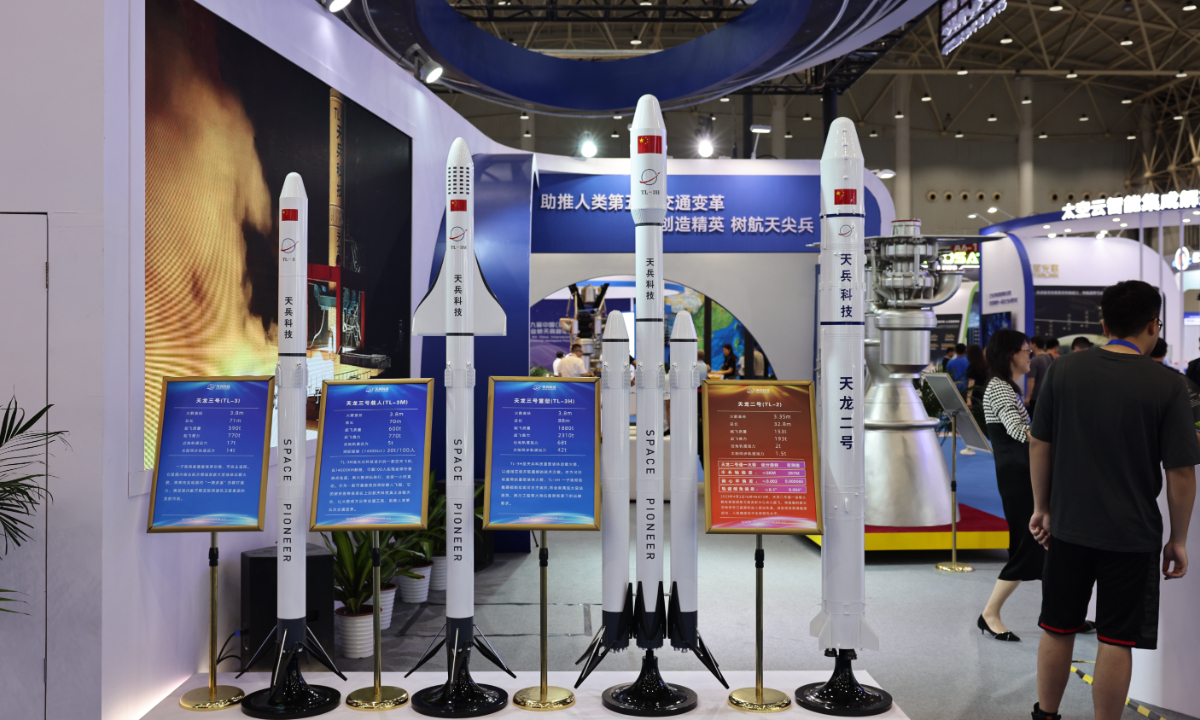Chinese private rocket company readies 'Falcon 9 equivalent' for maiden flight

Rockets and rocket engines on display in Wuhan on Wednesday. Photo: Deng Xiaoci/GT
Space Pioneer, a Chinese private rocket company founded in 2019, revealed that its new large liquid-propellent reusable rocket model TL-3, also known as the Chinese "Falcon 9 equivalent" for its matching powerful design, has come closer to its maiden flight scheduled for July this year. Its main power system - the 9 Tianhuo-12 variable thrust engines forming the rocket's first stage - completed a hot running test on Thursday, the last stage before final delivery.
Specially designed for China's low-orbit satellite internet constellation construction, the TL-3 rocket has a diameter of 3.8 meters, a total length of 71 meters and a liftoff mass of 590 tons. It is capable of sending a payload of 17 tons to the Low Earth orbit (LEO) and 14 tons to the Sun-synchronous orbit, according to the company.
In comparison, the SpaceX' Falcon 9 Full Thrust can carry 22.8 tons to LEO when in expendable mode, according to space industry news portal SpaceNews.com.
The rocket incorporates more than 50 new technologies including stainless steel 3D printed engines, liquid nitrogen vaporization pressurization, gas injection accumulators, triple redundant computers, nine-engine parallel configuration, full carbon fiber fairings, single-layer common bottom storage tanks and non-pyrotechnic separation, significantly enhancing cost-effectiveness. Additionally, the first stage of the TL-3 possesses the ability for autonomous return and reusability, further enhancing its capabilities.
The hot running test is the final stage of the engine delivery process, mainly aimed at comprehensively assessing the production quality of the engine, verifying the engine's operating conditions and mixture ratio adjustment accuracy, as well as inspecting the overall quality and performance of the engine before the delivery, the firm said.
The power system of TL-3 - the Tianhuo-12 rocket engine, with a sea-level thrust of 110 ton - has been independently developed and has comprehensively broken through multiple key technologies. Currently, 41 liquid rocket engines have been produced, 9 complete units have undergone assembly testing, and a high-condition thermal running verification has been achieved, Space Pioneer revealed on Thursday.
As the largest liquid rocket in the domestic commercial space circle, the TL-3 is set to become the first of its kind to possess the capability of sending more than 30 satellites all in one go, greatly enhancing the country's satellite internet's "low-cost, high-reliability, high-frequency" launch and networking capabilities, according to the Space Pioneer.
In 2024, the TL-3 rocket is scheduled to undertake a total of three launch missions, which are all included in the national launch plan. Within three years after its maiden flight, it will possess a commercial launch capacity of over 30 orbital launches per year.
Developing commercial spaceflight was listed among the key areas for development of emerging industries in this year's Government Work Report.
Industry insiders said the Government Work Report underlines the importance and strategic position of the commercial spaceflight industry and builds a foundation for potential policy support for fostering new quality productive forces.
"The TL-3 commercial heavy-lift liquid rocket will strongly support the rise of China's satellite internet industry, becoming a cornerstone force in the construction of low-orbit satellite constellations and assisting in the smooth implementation of the country's aerospace powerhouse strategy," a space industry observer who requested anonymity told the Global Times on Thursday.
China's space development is set to witness new milestones in 2024 with around 100 orbital launches expected to take place, setting a record and accelerating the networking and construction of multiple satellite constellations, according to the annual blue paper released by China's state-owned space giant China Aerospace Science and Technology Corporation (CASC) in February.
Photos
Related Stories
- China’s semiconductor export surges 28.6% in first two months, as efforts to shore up tech competitiveness pay off
- Chinese tech firm EHang sells low-altitude aircraft on e-commerce platform
- China accelerating development of two large reusable rocket models
- Rocket sends Queqiao 2 relay satellite to lunar orbit
- More scope for sci-tech innovation pledged
- China's advancements in global innovation dynamics inspiring
Copyright © 2024 People's Daily Online. All Rights Reserved.









